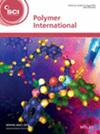Arjitha Saravanamuthu, Mohamed Mydeen Khaja Najimudeen, Krishnasamy Balaji, Kailasam Saravana Mani, Rathika Govindasamy, Alagar Muthukaruppan
求助PDF
{"title":"Modified guaiacol-based benzoxazines for optical, aggregation-induced emission and corrosion-resistant coating applications","authors":"Arjitha Saravanamuthu, Mohamed Mydeen Khaja Najimudeen, Krishnasamy Balaji, Kailasam Saravana Mani, Rathika Govindasamy, Alagar Muthukaruppan","doi":"10.1002/pi.6726","DOIUrl":null,"url":null,"abstract":"<p>Two new kinds of modified bifunctional and trifunctional guaiacol, namely 4,4′-(bis(4-fluorophenyl)methylene)bis(2-methoxyphenol) (BBM) and 4,4′-((2-hydroxy-4-methoxyphenyl)(phenyl)methylene)bis(2-methoxyphenol) (HBM), were synthesized using guaiacol with respective keto derivatives under appropriate experimental conditions. Two series of benzoxazines were developed with BBM and HBM using various amines (dodecylamine (dda), octadecylamine (oda), furfurylamine (ffa), aniline (a) and 4-fluoroaniline (fa)) with paraformaldehyde through Mannich condensation with a view to utilize them for anticorrosive and optical resistant coating applications. The molecular structures of the synthesized precursors and benzoxazine monomers were characterized using appropriate analytical techniques. The polymerization temperature of the benzoxazines was assessed using differential scanning calorimetry. Among the benzoxazine monomers synthesized, the monomer HBM-fa exhibits the lowest curing temperature (217 °C). Data obtained from thermogravimetric analysis indicated that the polybenzoxazines poly(BBM-ffa) and poly(HBM-ffa) possess higher thermal stability (455 and 425 °C) and higher char yield (54% and 60%) than the other polybenzoxazines. In both series, octadecylamine-based polybenzoxazines (BBM-oda and HBM-oda) exhibited the highest values of water contact angle of 148° and 149° respectively. Additionally, the benzoxazines showed aggregation-induced emission properties during fluorescence studies. Morphological analyses using different analytical techniques on selected polybenzoxazines were carried out before and after the corrosion process. Results from corrosion studies, i.e. Tafel and Nyquist plots, implied that the polybenzoxazines can be used as effective coating material to protect mild steels from corrosion. Data from different studies suggest that the developed benzoxazines can be used in the form of optical and anticorrosion coatings under thermally harsh and moist environments. © 2024 Society of Chemical Industry.</p>","PeriodicalId":20404,"journal":{"name":"Polymer International","volume":"74 4","pages":"353-370"},"PeriodicalIF":3.6000,"publicationDate":"2024-11-29","publicationTypes":"Journal Article","fieldsOfStudy":null,"isOpenAccess":false,"openAccessPdf":"","citationCount":"0","resultStr":null,"platform":"Semanticscholar","paperid":null,"PeriodicalName":"Polymer International","FirstCategoryId":"92","ListUrlMain":"https://scijournals.onlinelibrary.wiley.com/doi/10.1002/pi.6726","RegionNum":4,"RegionCategory":"化学","ArticlePicture":[],"TitleCN":null,"AbstractTextCN":null,"PMCID":null,"EPubDate":"","PubModel":"","JCR":"Q2","JCRName":"POLYMER SCIENCE","Score":null,"Total":0}
引用次数: 0
引用
批量引用
Abstract
Two new kinds of modified bifunctional and trifunctional guaiacol, namely 4,4′-(bis(4-fluorophenyl)methylene)bis(2-methoxyphenol) (BBM) and 4,4′-((2-hydroxy-4-methoxyphenyl)(phenyl)methylene)bis(2-methoxyphenol) (HBM), were synthesized using guaiacol with respective keto derivatives under appropriate experimental conditions. Two series of benzoxazines were developed with BBM and HBM using various amines (dodecylamine (dda), octadecylamine (oda), furfurylamine (ffa), aniline (a) and 4-fluoroaniline (fa)) with paraformaldehyde through Mannich condensation with a view to utilize them for anticorrosive and optical resistant coating applications. The molecular structures of the synthesized precursors and benzoxazine monomers were characterized using appropriate analytical techniques. The polymerization temperature of the benzoxazines was assessed using differential scanning calorimetry. Among the benzoxazine monomers synthesized, the monomer HBM-fa exhibits the lowest curing temperature (217 °C). Data obtained from thermogravimetric analysis indicated that the polybenzoxazines poly(BBM-ffa) and poly(HBM-ffa) possess higher thermal stability (455 and 425 °C) and higher char yield (54% and 60%) than the other polybenzoxazines. In both series, octadecylamine-based polybenzoxazines (BBM-oda and HBM-oda) exhibited the highest values of water contact angle of 148° and 149° respectively. Additionally, the benzoxazines showed aggregation-induced emission properties during fluorescence studies. Morphological analyses using different analytical techniques on selected polybenzoxazines were carried out before and after the corrosion process. Results from corrosion studies, i.e. Tafel and Nyquist plots, implied that the polybenzoxazines can be used as effective coating material to protect mild steels from corrosion. Data from different studies suggest that the developed benzoxazines can be used in the form of optical and anticorrosion coatings under thermally harsh and moist environments. © 2024 Society of Chemical Industry.
改性愈创木酚基苯并恶嗪用于光学,聚集诱导发射和耐腐蚀涂层
在适当的实验条件下,以愈创木酚及其酮衍生物为原料,合成了4,4′-(4-氟苯基)亚甲基-(2-甲氧基苯基)亚甲基-(4,4′-(2-羟基-4-甲氧基苯基)亚甲基-(2-甲氧基苯基)双(2-甲氧基苯酚)和4,4′-(2-羟基-4-甲氧基苯基)亚甲基-(2-甲氧基苯酚)HBM两种新型双官能团和三官能团愈创木酚。以十二烷基胺(dda)、十八烷基胺(oda)、糠胺(ffa)、苯胺(a)和4-氟苯胺(fa)等多种胺与多聚甲醛通过曼尼希缩合反应,以BBM和HBM为原料,开发了两个系列的苯并恶嗪,以期将其用于防腐和耐光涂层。采用相应的分析技术对合成的前体和苯并恶嗪单体的分子结构进行了表征。用差示扫描量热法测定了苯并恶嗪的聚合温度。在合成的苯并恶嗪单体中,单体HBM-fa的固化温度最低(217℃)。热重分析结果表明,聚苯并恶嗪聚(BBM-ffa)和聚(HBM-ffa)具有较高的热稳定性(455℃和425℃)和较高的炭产率(54%和60%)。在这两个系列中,十八胺基聚苯并恶嗪(BBM-oda和HBM-oda)的水接触角值最高,分别为148°和149°。此外,在荧光研究中,苯并恶嗪表现出聚集诱导的发射特性。采用不同的分析技术对所选的聚苯并恶嗪进行了腐蚀前后的形态分析。腐蚀研究的结果,即Tafel和Nyquist图,表明聚苯并恶嗪可以作为有效的涂层材料来保护低碳钢免受腐蚀。来自不同研究的数据表明,所开发的苯并恶嗪可以在热恶劣和潮湿的环境下以光学和防腐涂层的形式使用。©2024化学工业学会。
本文章由计算机程序翻译,如有差异,请以英文原文为准。




 求助内容:
求助内容: 应助结果提醒方式:
应助结果提醒方式:


